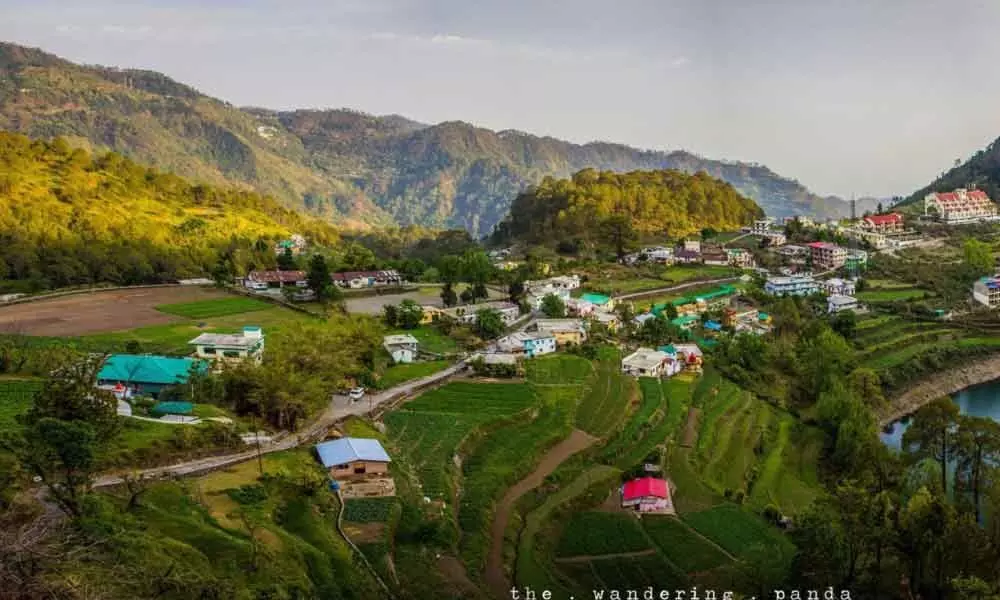A feel of real Kumaon: Little village sits on the spine of a hill and looks to an architect's eye like a medieval town

Garur Valley in Uttarakhand, with its deep river valleys and the countless small terraced fields is a collage of many beautiful things all fitted into a single frame…
It was almost evening when we reached Ana, a small village in the Garur Valley. The road from the Garur market was remote and lined with trees. The snowclad peaks of the Himalayas majestically lined the horizon, with more and more peaks looming into view as we gained height with every serpentine turn on the mountain road. Then as dusk fell, the lights of the Garur Valley twinkled in the distance. It looked magical – as if some of the stars had chosen to descend on earth for a change.
My visit to the Garur Valley happened by chance and I instantly fell in love with this part of Kumaon, which still retains its unique character and has not been overrun by crass commercialization as it has happened to the hill stations of Almora, Nainital and yes, even Kausani. The tiny hamlet of Kausani where Mahatma Gandhi had stayed in 1929 to recover from the rigours of his British imprisonment is drastically different from the Kausani of today which looks all set on its way to becoming another congested Himalayan town. 'Why do people have to go to Switzerland when we have Kausani here?' Gandhiji had pondered while visiting this place almost a century ago. I wonder if he would still have felt the same had he visited today.
The little hamlets of the Garur Valley, on the contrary, still retain much of their quintessential charm and Ana is one such place. The little village sits on the spine of a hill and looks – to an architect's eye – like a medieval town. It consists of a long line of row houses of different types, most with their own paved courtyards separated by low boundary walls. Their levels differ, and stone steps lead from one to the next.
The row houses of Ana show all the typical features of Kumaoni row houses known as 'bakhlis'. The walls are built of rubble stone, the open-fronted ground floor houses the animals, and the dwelling place of their owners above rests on mighty wooden beams. More sturdy wooden beams form the framework of the roof, which consists of slate tiles. The area in front of the row houses is neatly paved with slate slabs. The front of the first-floor dwelling place consists partly of rubble stone, partly of wood and looks like the window feature described by Edwin T Atkinson in his Himalayan Gazetteer, whose six volumes were published between 1881 and 1886. While describing the Kumaoni houses, he remarks "the windows are mere apertures…resembling pigeonholes cut in the wooden panels and closed by a slide". But the small windows are surrounded by pretty, carved wooden frames and make for a pretty picture.
The Garur Valley with its deep river valleys and the countless small terraced fields on the steep mountain slopes, with the deodar woods on the higher sections, is a collage of many beautiful things all fitted into a single frame. On many days we enjoyed a splendid view of the majestic snow peaks in the direction of Tibet.
The lack of material wealth in this part of Kumaon is offset by its rich traditional architecture and a wealth of religious customs and festivals. Traces of the great Hindu mythology are found in many places where the Pandavas are supposed to have roamed. Many of the festivals – some lasting up to three weeks – are devoted to local deities and haven't changed much since Edwin T. Atkinson described them in his Himalayan Gazetteer.
Around 5-6 km from Ana there is a temple of Kot Bhramri Devi which once was a fort owned by the Katyuri Kings. There is a myth that Adi Shankaracharya stayed on this temple overnight while en route to Badrinath. There is a widespread belief among the local populace that the face of the goddess Kot Bhramri Devi should not be shown to anyone except the priest of the temple. It is said that if this advice is not followed, the entire Katur Valley will face ill-luck and a massive disaster will follow. Hence only the rear side of the goddess is worshipped, except during the annual festival of 'Nandaashtmi'.
Enveloped in mythologies, anecdotes and a glorious past Garur valley reveals itself as a wonderfully enchanting destination. Once the capital of the great Katyuri kings of Kumaon, the valley is dotted with ancient temples. These exquisitely carved and sculptured temples were built by the Katyuri kings and are considered as some of the finest creations of the Western Himalayas. We visited the Baijnath temple located on the banks of the Gomti river. The river near the temple is home to scores of huge fish. A boy of about eight years appeared before us and began peddling little packets of chana to feed the fish, which seemed to swim towards us in anticipation of the treat.
We complied with the boy's requests, fed the fish by the riverbank and later treaded over crumbling leaves shed by the trees. On our drive back from the temple through the Garud Valley, the tea gardens by the main road enticed us. We were not aware that Uttarakhand has its own brand of tea called Girias. We stopped at a tiny open-air roadside café located on the rooftop. Sipping the hot brew with no one in sight and only the sight of the towering Himalayas before us we felt as if we had stepped into a different time zone and era — a place where no one was ever stressed or in a hurry.














